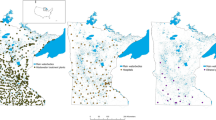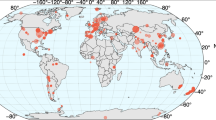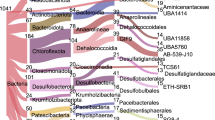Abstract
The role of environmental selection in governing the structure of communities of freshwater sulfur bacteria (Achromatium spp) was experimentally tested by mixing sediments from two geographically separated lakes (Rydal Water (RY) and Hell Kettles (HK)) that harboured Achromatium spp. Community profiles of Achromatium spp in sediment microcosms at day 0 and after 60 days were compared to determine whether initial Achromatium community composition or subsequent selection by the sediment environment had greater influence in dictating the final Achromatium community structure. It was found that Achromatium spp from the HK community became established in mixed sediments at the expense of members of the RY community. This selection for the HK Achromatium community was more pronounced when sediment composition was manipulated to resemble HK sediments. Our findings definitively demonstrate that environmental selection is the primary determinant of Achromatium community structure in these sediments.
Similar content being viewed by others
Log in or create a free account to read this content
Gain free access to this article, as well as selected content from this journal and more on nature.com
or
Accession codes
References
Altschul SF, Gish W, Miller W, Myers EG, Lipman DJ . (1990). Basic alignment search tool. J Mol Biol 214: 403–410.
Ashelford KE, Weightman AJ, Fry JC . (2002). PRIMROSE: a computer program for generating and estimating the phylogenetic range of 16S rRNA oligonucleotide probes and primers in conjunction with the RDP-II database. Nucl Acids Res 30: 3481–3489.
Baas-Becking LGM . (1934). Geobiologie of Inleiding Tot de Milieukunde. Van Stockum and Zoom: The Hague.
Begon M, Harper JL, Townsend CR . (1996). Ecology: Individuals, Populations and Communities, 3rd edn. Blackwell Science Ltd: Oxford, pp 861–883.
Bell T, Ager D, Song J-I, Newman JA, Thompson IP, Lilley AK et al. (2005a). Larger islands house more bacterial taxa. Science 308: 1884.
Bell T, Newman JA, Thompson IP, Lilley AK, van der Gast CJ . (2005b). Response—bacteria and island biogeography. Science 309: 1998–1999.
Cho JC, Tiedje JM . (2000). Biogeography and degree of endemicity of fluorescent pseudomonas strains in soil. Appl Environ Microbiol 66: 5448–5456.
Clarke KR, Warwick RM . (2001). Change in Marine Communities: An Approach to Statistical Analysis and Interpretation, 2nd edn. PRIMER-E: Plymouth, UK, 38pp.
Cole JR, Chai B, Farris RJ, Wang Q, Kulam-Syed-Mohideen AS, McGarrell DM et al. (2007). The ribosomal database project (RDP-II): introducing myRDP space and quality controlled public data. Nucl Acids Res 35 (database issue): D169–D172.
de Boer WE, La Rivière JWM, Schmidt K . (1971). Some properties of Achromatium oxaliferum. Antonie Leeuwenhoek 37: 553–563.
Edwards U, Rogall T, Blöcker H, Emde M, Böttger EC . (1989). Isolation and direct complete nucleotide determination of entire genes. Characterisation of a gene coding for 16S ribosomal RNA. Nucl Acids Res 17: 7843–7853.
Fenchel T, Finlay BJ . (2005). Bacteria and island biogeography. Science 309: 1997.
Finlay BJ . (2002). Global dispersal of free-living microbial eukaryote species. Science 296: 1061–1063.
Glöckner FO, Babenzien H-D, Wulf J, Amann R . (1999). Phylogeny and diversity of Achromatium oxaliferum. Syst Appl Microbiol 22: 28–38.
Gray ND, Comaskey D, Howarth R, Miskin IP, Pickup RW, Suzuki K et al. (2004). Adaption of sympatric Achromatium spp. to different redox conditions as a mechanism of coexistence for functionally similar sulfur bacteria. Environ Microbiol 6: 669–677.
Gray ND, Head IM . (1999). New insights on old bacteria: diversity and function of morphologically conspicuous sulfur bacteria in aquatic systems. Hydrobiologia 401: 97–112.
Gray ND, Howarth R, Pickup RW, Jones JG, Head IM . (1999a). Substrate utilisation by the uncultured bacteria from the genus Achromatium determined by the use of microautoradiography. Appl Environ Microbiol 65: 5100–5106.
Gray ND, Howarth R, Rowan A, Pickup RW, Jones JG, Head IM . (1999b). Natural communities of Achromatium oxaliferum comprise genetically morphologically and ecologically distinct sub-populations. Appl Environ Microbiol 65: 5089–5099.
Gray ND, Pickup RW, Jones JG, Head IM . (1997). Ecophysiological evidence that Achromatium oxaliferum is responsible for the oxidation of reduced sulfur species to sulfate in a freshwater sediment. Appl Environ Microbiol 63: 1905–1910.
Green JL, Holmes AJ, Westoby M, Oliver I, Briscoe D, Dangerfield M et al. (2004). Spatial scaling of microbial eukaryote diversity. Nature 432: 747–750.
Head IM, Gray ND, Clarke KJ, Pickup RW, Jones JG . (1996). The phylogenetic position and ultrastructure of the uncultured bacterium Achromatium oxaliferum. Microbiology 142: 2341–2354.
Head IM, Gray ND, Howarth R, Pickup RW, Clarke KJ, Jones JG . (2000). Achromatium oxaliferum—understanding the unmistakable. Adv Microb Ecol 16: 1–40.
Horner-Devine MC, Carney KM, Bohannan BJM . (2004). An ecological perspective on bacterial biodiversity. Proc R Soc Lond B Biol Sci 271: 113–122.
Hughes Martiny JB, Bohannan BJM, Brown JM, Colwell RK, Fuhrman JA, Green JL et al. (2006). Microbial biogeography: putting microorganisms on the map. Nature Microbial Rev 4: 102–112.
Jukes TH, Cantor CR . (1969). Evolution of protein molecules. In: HN Munro (ed). Mammalian Protein Metabolism. Academic Press: New York, pp 21–132.
MacArthur RH, Wilson EO . (1967). The Theory of Island Biogeography. Princeton University: Princeton, NJ.
Muyzer G, De Waal EC, Utterlinden AG . (1993). Profiling of complex microbial populations by denaturing gradient gel electrophoresis analysis of polymerase chain reaction-amplified genes coding for 16S rRNA. Appl Environ Microbiol 59: 695–700.
Oda Y, Star B, Huisman LA, Gottschal JC, Forney LJ . (2003). Biogeography of the purple nonsulfur bacterium Rhodopseudomonas palustris. Appl Environ Microbiol 69: 5186–5191.
Papke RT, Ramsing NB, Bateson MM, Ward DM . (2003). Geographical isolation in hot spring cyanobacteria. Environ Microbiol 5: 650–659.
Rainey PB, Travisano M . (1998). Adaptive radiation in a heterogeneous environment. Nature 394: 69–72.
Rauch EM, Bar-Yam Y . (2004). Theory predicts the uneven distribution of genetic diversity within species. Nature 431: 449–452.
Reche I, Pulido-Villena E, Morales-Baquero R, Casamayor EO . (2005). Does ecosystem size determine aquatic bacterial richness? Ecology 86: 1715–1722.
Rowan AK, Snape JR, Fearnside D, Barer MR, Curtis TP, Head IM . (2003). Composition and diversity of ammonia-oxidising bacterial communities in wastewater treatment reactors of different design treating identical wastewater. FEMS Microbiol Ecol 43: 195–206.
Saitou N, Nei M . (1987). The neighbor-joining method: a new method for reconstructing phylogenetic trees. Mol Biol Evol 4: 406–425.
Thorpe RS . (2005). Population evolution and island biogeography. Science 310: 1778–1779.
van De Peer Y, De Wachter R . (1994). TREECON for Windows—a software package for the construction and drawing of evolutionary trees for the Microsoft Windows environment. Comput Appl Biosci 10: 569–570.
van der Gast CJ, Lilley AK, Ager D, Thompson IP . (2005). Island size and bacterial diversity in an archipelago of engineering machines. Environ Microbiol 7: 1220–1226.
van Verseveld HW, Röling WFM . (2004). Cluster analysis and statistical comparison of molecular community profile data. In: Kowalchuk GA, de Bruijn FJ, Head IM, Akkermans AD, van Elsas JD (eds). Molecular Microbial Ecology Manual, 2nd edn. Springer: New York, pp 1373–1397.
Whitaker RJ, Grogan DW, Taylor JW . (2003). Geographic barriers isolate endemic populations of hyperthermophilic archaea. Science 301: 976–978.
Whitfield J . (2005). Biogeography: is everything everywhere? Science 310: 960–961.
Acknowledgements
This work was supported by Grant F/00125/D from the Leverhulme Trust. We are greatly indebted to Tom Wagner for critically reviewing earlier versions of the manuscript.
Author information
Authors and Affiliations
Corresponding author
Rights and permissions
About this article
Cite this article
Gray, N., Brown, A., Nelson, D. et al. The biogeographical distribution of closely related freshwater sediment bacteria is determined by environmental selection. ISME J 1, 596–605 (2007). https://doi.org/10.1038/ismej.2007.74
Received:
Revised:
Accepted:
Published:
Issue date:
DOI: https://doi.org/10.1038/ismej.2007.74
Keywords
This article is cited by
-
Evaluation of hydrolysis and fermentation rates in microbial fuel cells
Applied Microbiology and Biotechnology (2011)
-
Evolutionary divergence and biogeography of sympatric niche-differentiated bacterial populations
The ISME Journal (2010)



